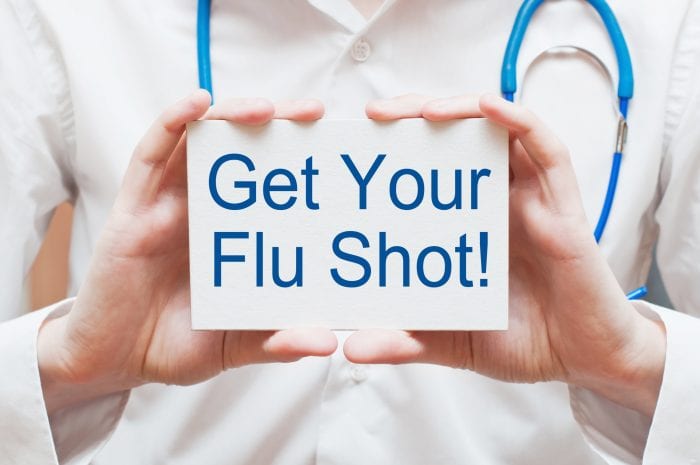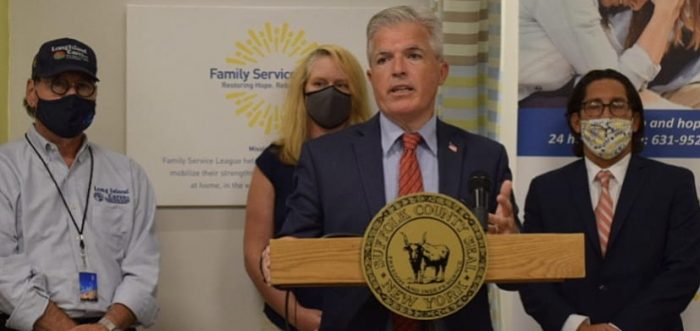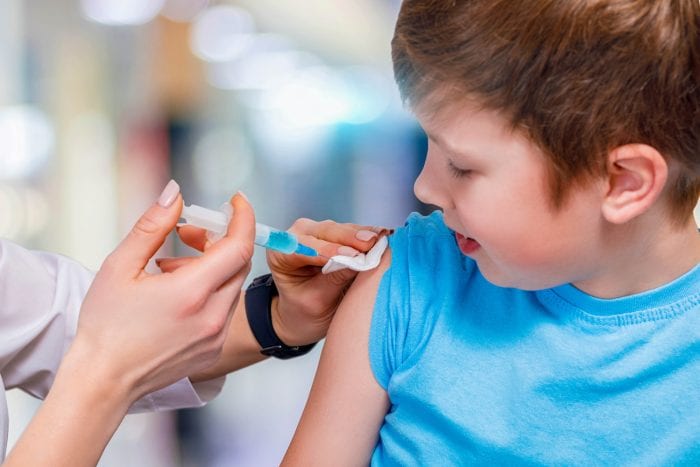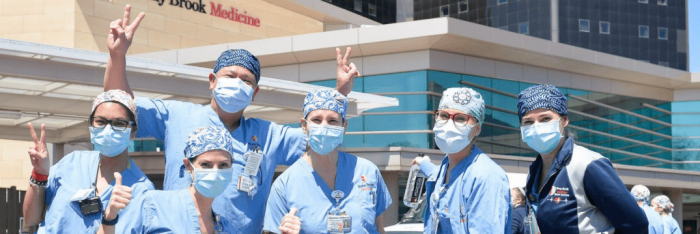Comsewogue Public Library, 170 Terryville Road, Port Jefferson Station hosts a flu shot clinic on Thursday, Oct. 8 from 11 a.m. to 2 p.m. A pharmacist from Genoa Health will be on-site to administer flu shots. The event will be held outdoors, weather permitting. Bring your insurance card. Open to all. Questions? Call 631-928-1212 and ask for Adult Services.
Fortunato Breast Health Center buckles down on pandemic precautions
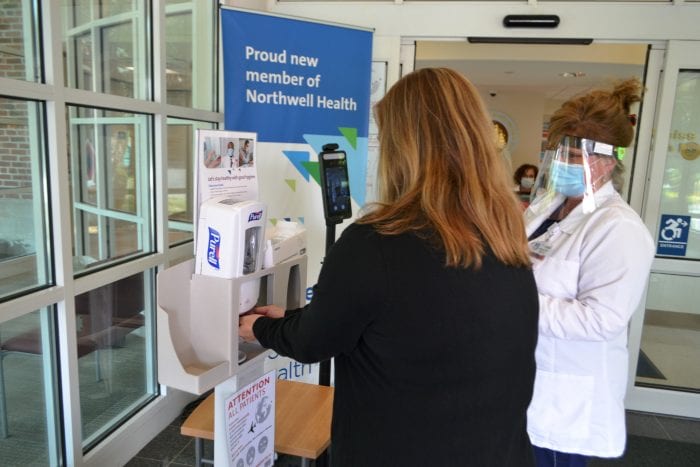
Early detection is crucial in diagnosing and treating breast cancer. But screenings in the time of the COVID-19 pandemic have become more complicated, with many screening centers closing for a time and patients fearful to come into a hospital or clinic setting. Mather Hospital’s Fortunato Breast Health Center has responded with strict safety protocols designed to protect patients and staff.
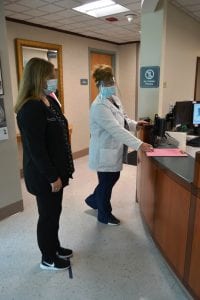
“As always with breast cancer and other cancers, your best bet is to have an early diagnosis,” said Breast Center Co-Medical Director Michelle Price, MD. “The importance of early detection cannot be overstated. Therefore, we have adapted protocols so that we can continue to provide expert care in the setting of the COVID-19 pandemic.”
The Breast Center recommends that women receive their first screening mammography at age 40 and continue annual screening every year thereafter. Many professional societies involved with the diagnosis and treatment of breast cancer also continue to recommend annual screening mammography starting at age 40, including the Society for Breast Imaging, American College of Radiology and National Comprehensive Cancer Network. In some high-risk situations, screening may begin even earlier.
Strict safety protocols have been implemented at the Breast Center in response to the COVID-19 pandemic. Dr. Price said this includes all staff and patients wearing masks at all times, everyone undergoing temperature checks when they arrive at the Breast Center, patients completing a COVID screening questionnaire about possible exposure to the virus, and the use of sanitizing gel.
“We no longer routinely have patients use waiting rooms, to minimize personal interactions,” said Dr. Price. “When patients arrive, they first call from their car, and are brought in one at a time for a streamlined experience.”
Where patients once routinely filled out a medical history form to provide information, the technologist now interviews the patient and records the pertinent data. This change eliminates the need for patients to handle a pen and paper.
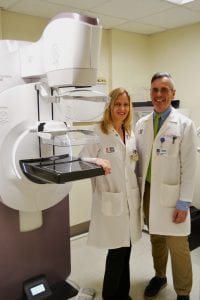
“We have a socially distant protocol where the patient has very limited contact with anyone else, providing maximal safety. The technologist brings the patient to the mammography room, where she is provided a gown to change in to privately. When ready, the technologist enters the room and performs the mammogram. When the study is complete, the patient is again given privacy to get dressed, and she is escorted out of the department by the technologist. As has always been the case, the imaging equipment is thoroughly disinfected between patients. People seem very satisfied with what we have done from the point of safety protocols. It’s a similar setup they’ve experienced at other doctors’ offices,” said Dr. Price who stressed the importance of continuing with annual mammograms despite the pandemic.
“Early in the pandemic, non-urgent medical care was postponed, but now the situation has changed,” she said. “The current consensus is that screening should continue if it can be done safely. We have implemented protocols to maximize safety for patients and staff alike. Early detection of breast cancer offers us the best chance for successful treatment.”
The Fortunato Breast Center uses advanced 3D mammography that is designed to make screening more comfortable. The 3D mammography also offers sharper, clearer images for improved diagnostic accuracy all while providing the lowest radiation dose of all FDA approved mammography systems.
Fortunato Breast Center radiologists are specialists who only read breast imaging studies and look back as far as possible at a patient’s history of breast images for any subtle changes or abnormalities in order to provide the most accurate reading.
Should a patient have a breast cancer diagnosis, the Breast Center’s compassionate nurse navigators provide personal guidance with scheduling appointments for tests and follow-up procedures, getting prescriptions, insurance questions, and any other help patients may need. The Breast Center’s nurse navigators provide support throughout every step of the patients’ journey to recovery.
The Breast Center offers no cost or discounted mammography screenings for those individuals with low income and no health insurance. For more information, visit www. matherhospital.org/breasthealth or call 631-476-2771.
All photos courtesy of Mather Hospital
Bellone: Suffolk Needs $400M in Federal Relief to Prevent Healthcare Cuts
Suffolk County Executive Steve Bellone (D) announced this week that the county will have no choice but to make catastrophic budget cuts to contract agencies that receive county funding if federal funds don’t come in.
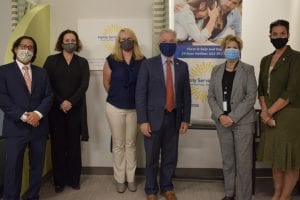
In a press conference at the Hauppauge-based Diagnostic, Assessment, and Stabilization Hub Wednesday, Sept. 30, Bellone said services like DASH, which offers drug and family emergency care, could face serious consequences if the federal government doesn’t get involved.
The conference was one in a series of pleas to top federal representatives to send aid to local governments as the impending budget crunch draws near.
“We’re still grappling with the virus’ impacts and aftermath within our community,” he said. “There’s too much riding on this for Washington to not get involved.”
Through federal inaction, Suffolk County will be forced to slash funding at unprecedented levels for agencies that provide services for the most vulnerable, according to Bellone. Along with the county executive, heads of several organizations stood by, explaining how the federal cuts could affect the help they provide to the community.
Healthcare and mental health services, addiction and domestic violence help and even safe childcare are in need of funding to keep going.
“Not-for-profits are the fabrics of our community,” Karen Boorshtein, president and CEO of the Family Service League, said. “Without them, everyone is going to suffer.”
Paule Pachter, CEO Long Island Cares, said that his organization, which brings resources to help feed the hungry on Long Island, has seen huge increases in people waiting in line for food.
“Priorities in the USA are completely unacceptable,” he said. “110,000 [hungry] people, an additional 50,000, will become part of the lasting effects if Washington doesn’t take this seriously.”
Representatives from the Child Care Council of Suffolk, the Long Island Council on Alcoholism and Drug Dependence and L.I. Against Domestic Violence all said they’ve experienced drastic increases in service inquiries during the pandemic.
Colleen Merlo, executive director of LIADV, said the road to recovery for survivors of domestic violence will be painful and slow, especially without federal aid.
“We’ve been up 31% in calls,” she said. “Counseling services have doubled.”
Executive director of LICADD, Steve Chassman, said because of the COVID-19 crisis, addiction numbers have skyrocketed.
“We have propelled to where we were 6 months ago,” he said.
Bellone made a direct appeal to President Trump requesting that he call upon U.S. Senate Majority Leader Mitch McConnell to pass a federal disaster assistance bill in the U.S. Senate to prevent these potential devastating cuts.
He said he’s been working alongside counties throughout the state who all agree help is needed.
“This isn’t partisan, and it shouldn’t be,” he said. “Politics has no place there.”
Earlier this year, Bellone created a COVID-19 Fiscal Impact Task Force to conduct an independent review of the county’s multi-year plan and the true impact to the pandemic. The report found that Suffolk County could face a cumulative budget shortfall of up to $1.5 billion over the next three years because of the economic fallout of the pandemic.
Bellone said the county will need nearly $400 million in federal relief this year to avoid these “devasting” cuts that “should not happen.”
“We’ve seen incredible strength and compassion, while also dealing with pain and trauma,” he said. “We’ve been up and down the mountain, we’ve flattened the curve, and we’ve done that by coming together, supporting each other, and that’s what we have to do if we’re going to recover.”
Paint Port Pink 2020 lights the way in the fight against breast cancer

And then there was light. Paint Port Pink, Mather Hospital’s annual breast cancer awareness campaign will kick off today, Oct.1, with the lighting of pink lights throughout the Village of Port Jefferson and in Port Jefferson Station. The month-long breast health outreach by Mather’s Fortunato Breast Health Center raises awareness, provides educational information and fosters solidarity in the community.
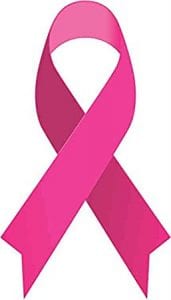 This year’s campaign, sponsored by New York Cancer & Blood Specialists, will join with its annual fundraising event Families Walk for Hope, which supports the Fortunato Breast Health Center. The Walk, a five-mile breast cancer fundraiser held the first Saturday in May, was postponed due to the COVID-19 pandemic and is now taking place virtually through the end of October. The Walk this year will benefit the Fortunato Breast Health Center and Mather’s COVID-19 Emergency Fund. As a thank you and a reminder to wear a mask, anyone donating $10 or more to the Walk will receive a handmade mask. Register at www.familieswalkforhope.org
This year’s campaign, sponsored by New York Cancer & Blood Specialists, will join with its annual fundraising event Families Walk for Hope, which supports the Fortunato Breast Health Center. The Walk, a five-mile breast cancer fundraiser held the first Saturday in May, was postponed due to the COVID-19 pandemic and is now taking place virtually through the end of October. The Walk this year will benefit the Fortunato Breast Health Center and Mather’s COVID-19 Emergency Fund. As a thank you and a reminder to wear a mask, anyone donating $10 or more to the Walk will receive a handmade mask. Register at www.familieswalkforhope.org
New this year is a Virtual Paint Night, hosted by Mather’s 2 South oncology and medical/surgical unit. Register at www.matherhospital.org/paintnight Also new is a “Mask-querade” mask decorating contest. Participants are asked to “pink” their masks and send photos to [email protected] by Oct. 20, as well as posting on social media with the #paintportpink. The winner will be selected on Oct. 21 and receive a $100 gift card.
The hospital’s HealthyU webinar series will present four webinars on breast cancer each Tuesday in October from noon to 1 p.m. The series will look at diagnosis, treatment, surgery and breast reconstruction. Register for these webinars at www.matherhopsital.org/healthyu.
Returning this year is the Pink Your Pumpkin contest. Photos of “pinked” pumpkins can also be emailed to [email protected] by Oct. 20 and posted on social media with #paintportpink. The winner will be chosen on Oct. 21 and will receive a $100 gift card.

Wear Pink Day takes place virtually on Friday, Oct. 16. Community members are urged to dress in pink in support of breast cancer awareness and post selfies on social media with #paintportpink. Photos can also be mailed to [email protected] to be included in a collage on Mather’s Facebook page. Don’t have anything pink to wear? Register for the Families Walk for Hope and receive an official pink t-shirt that can be used for your selfie.
The Port Jefferson Free Library celebrates Paint Port Pink with a Cherry Blossom Lantern workshop on Thursday, October 15, from 3 to 4 p.m. Participants will be guided step by step to paint their own lantern in a beautiful cherry blossom pattern. Register at https://tinyurl.com/cherryblossomlanterns.
A calendar of events and a list of Paint Port Pink community partners offering promotions to benefit the Fortunato Breast Health Center’s Fund for Uninsured is at www.matherhospital.org/pink. Register for the Families Walk for Hope at www.familieswalkforhope.org Call 631-476-2723 for more information.
Medical Compass: Osteoarthritis approaches
Focus on reducing pain and improving mobility
By David Dunaief, M.D.

Osteoarthritis has been diagnosed in over 54 million Americans, with 43.5 percent of them reporting symptoms that limit their activities and significantly impact their quality of life (1). Historically, the disorder was thought to be solely a wear-and-tear degeneration of the joint(s). However, Osteoarthritis (OA) also involves inflammation with the release of cytokines and prostaglandins — inflammatory factors — which cause joint destruction and pain (2).
The joints most commonly affected include the ankle, knee, hip, spine and hand. OA may affect joints asymmetrically, meaning that it affects a joint on only one side of the body.
Mainstays of treatment include analgesics and COX-2 inhibitors (Celebrex). Common analgesics used are acetaminophen and NSAIDs, such as ibuprofen (Advil), naproxen sodium (Aleve). A benefit of NSAIDs is that they have anti-inflammatory effects. Meanwhile, COX-2 inhibitors may also improve joint mobility.
There are adverse effects with NSAIDs, including increased gastrointestinal (or GI) bleed and, with long-term use, an increase in cardiovascular events, such as heart attacks, with the elderly being most susceptible.
Neither medication type, however, structurally modifies the joints. In other words, they may not slow OA’s progression nor rebuild cartilage or the joint space as a whole. Are there therapies that can accomplish these feats and, if so, what are they? We will look at hyaluronic acid, glucosamine and chondroitin, and lifestyle modifications such as exercise and weight loss.
Chondroitin sulfate beneficial for hand OA
The results with the use of glucosamine and chondroitin have been mixed, depending on the joints affected. In the FACTS trial, a randomized controlled trial, chondroitin sulfate by itself showed significant improvement in pain and function with OA of the hand (3). The dose of chondroitin used in the study was 800 mg once a day. The patients, all of whom were symptomatic at the trial’s start, also saw the duration of their morning stiffness shorten.
There was also a modest reduction in structural damage of hand joints after three months, compared to placebo. The benefit was seen with prescription chondroitin sulfate, so over-the-counter supplements may not work the same way. Patients were allowed to use acetaminophen, and there was no change in dose or frequency throughout the trial.
Crystalline glucosamine sulfate
In knee OA, crystalline glucosamine sulfate showed reduction in pain and improvement in functioning in a randomized controlled trial (4). When assessed by radiologic findings, it also slowed the progression of structural damage to the knee joint. In other words, the therapy may have disease-modifying effects over the long term. The glucosamine formulation may work by inhibiting inflammatory factors such as NF-kB. The trial used 1500 mg of prescription crystalline glucosamine sulfate over a three-year period. Again, it’s not clear whether an over-the-counter supplement works the same way.
Glucosamine and/or chondroitin for knee OA
In a meta-analysis (group of 10 studies), glucosamine, chondroitin or the combination did not show beneficial effects — reduced pain or mobility changes — in patients when compared to placebo (5). It was not clear whether supplemental or prescription-level therapies were used in each trial — or whether that makes a difference. This study was published prior to the crystalline glucosamine sulfate trial of the knee, discussed above, which did show statistical significance.
There is not much downside to using glucosamine and/or chondroitin for OA patients. However, use caution if taking an anticoagulant (blood thinner) like Coumadin, since glucosamine has anticoagulant effects. Also, those with shellfish allergies should not use glucosamine. If there is no effect within three months, it is unlikely that glucosamine and/or chondroitin are beneficial.
Hyaluronic acid
In a meta-analysis (a group of 89 trials), the risks outweighed the benefit of hyaluronic acid, a drug injected into the joint for the treatment of OA (6). Viscosupplementation involves a combination of hyaluronic acid types that act as a shock absorber and lubricant for the joints. Some of the studies did show a clinical benefit. However, the authors believe that adverse local events, which occurred in 30 to 50 percent of patients, and serious adverse events, with 14 trials showing a 41 percent increased risk, outweigh the benefits. Since there are mixed results with the trials, it is best to discuss this option with your physician.
Impact of weight loss and exercise
Obesity treatment with a weight-loss program actually has potential disease-modifying affects with OA (7). It may prevent cartilage loss in the medial aspect of the knee. The good news is that, even with as little as a seven percent weight loss in the obese patient, these results were still observed. The study’s average weight loss was nine to 10 pounds, and results were seen on a dose-response curve — the greater the weight loss, the thicker the knee cartilage.
Writing in The New England Journal of Medicine, Dr. David Felson observed there is an inverse relationship between the amount of muscle-strengthening exercise, especially of the quadriceps, and the amount of pain experienced in the knee joint. It is very important to do nonimpact exercises such as leg raises, squats, swimming, bicycling and on elliptical machines.
Fortunately, there are a number of options to prevent, treat and potentially modify the effects of OA. With weight loss in the obese patient, quality of life can dramatically increased. Glucosamine and/or chondroitin may be of benefit, depending on the joints affected. The benefits are potential improvements in pain, mobility and structural-modifying effects, which are worth the risk for many patients. When taking glucosamine and/or chondroitin in supplement form, ConsumerLab.com may be a good source for finding a supplement where you get the dose claimed on the box. I would also use formulations in the trials that showed results, even in supplement form.
References:
(1) MMWR Morb Mortal Wkly Rep. 2017 Mar 10;66(9):246-253. (2) Rheumatology. 2011;50(12):2157-2165. (3) Arthritis Rheum. 2011 Nov;63(11):3383-91. (4) Ther Adv Musculoskel Dis. 2012;4(3):167-180. (5) BMJ. 2010;341:c4675. (6) Ann Intern Med. 2012;157(3):180-191. (7) Ann Rheum Dis. 2012;71(1):26-32.
Dr. David Dunaief is a speaker, author and local lifestyle medicine physician focusing on the integration of medicine, nutrition, fitness and stress management. For further information, visit www.medicalcompassmd.com.
Doctors Recommend Getting Flu Shots Now
Get a flu shot now.
While timing a flu shot can seem like timing the stock market — buying or selling a stock now might mean missing out on gains later — it’s not. A flu shot generally provides immunological coverage against the flu from about four weeks after the shot until six months later.
With a flu season that doesn’t follow a yearly calendar, residents sometimes try to balance between minimizing the possible effect of exposure to the flu in the next few weeks with exposure to the flu in the middle of the spring.
“It makes most health professionals very uncomfortable when people [suggest holding off on protection through the spring] as a reason to delay immunization, as it takes four weeks for protective antibodies to mature,” said Michael Grosso, Chief Medical Officer at Huntington Hospital. Influenza season can begin as early as November and sometimes earlier, so “any time now would be the right time.”
Medical professionals urged people to be even more proactive about getting a flu shot this year, as the pandemic continues to lurk in the shadows, on door knobs, and within six feet of an infected individual.
When people contract the flu along with other respiratory illnesses, the combination, as people might expect, can cause significant sickness.
“The novel coronavirus is just that, it’s novel,” Grosso said. “We don’t know exactly how it will interact with influenza. We do have significant prior experience with concurrent infections with other respiratory viruses. Individuals coinfected with one or more serious respiratory viruses frequently get sicker.”
That’s the case for both children and adults, Grosso added.
Getting an influenza vaccine could also reduce the confusion that will occur if people experience flu-like symptoms, which are also a hallmark of COVID-19 cases.
“Getting as much of the population immunized as possible is even more important than at other times,” Grosso said.
Each year, somewhere between 150,000 to 180,000 people are hospitalized from the flu and the death toll can range between 12,000 to 61,000 people per year in the U.S.
Doctors recommended that people who are 65 and older get a quadrivalent flu shot, which includes an additional influenza B strain.
In a trial of 30,000 people over 65, people who received the quadrivalent shot had 24% fewer illnesses compared to those who got the standard shot, according to the Centers for Disease Control and Prevention.
Susan Donelan, Medical Director of Healthcare Epidemiology at Stony Brook Medicine, said the side effects of the flu shot include an uncomfortable arm for a few days, a low grade fever and fatigue.
“The vast majority of people can easily manage the minor side effects for a day or two with Tylenol or Ibuprofen or a cold pack on their arm,” Dr. Donelan said.
Doctors said practices such as wearing a mask, social distancing and frequent hand washing, which are designed to reduce the spread of COVID-19, are also helpful in cutting down on the transmission of the flu.
Those measures will only help if residents exercise them correctly. Masks that fall below the nose of the wearer, which may make it easier to breathe, are not as effective at reducing the spread of these viruses, Dr. Donelan said.
What to Watch Out For with Flesh-Eating Bacteria

With reports of five people who have been infected with flesh-eating bacteria across the Long Island Sound in Connecticut, area doctors answered questions about the dangerous pathogen.
For starters, the bacteria in Connecticut is called Vibrio vulnificus, and even though it’s extremely rare, it is especially problematic for people who have open wounds and have gone swimming in warm, salty or brackish — a combination of fresh and salty — waters.
Smaller cuts aren’t as much of a likely entry point for these bacteria, but open wounds such as skinned knees or elbows are, said Dr. Sharon Nachman, chief of Division of Pediatric Infectious Diseases at Stony Brook Children’s Hospital.
Those residents with open wounds who have swum in salty or brackish water can lower the risk of infection by washing their wounds with soap and freshwater soon after coming out of the water.
“Soap and water work,” Nachman said. “If you have no access to soap, regular water would be great.”
Vibrio is a rapidly spreading bacteria and is often visible soon after swimming.
“If you swim and you have an open wound and it looks different an hour or two after you get home than it did that morning, seek medical attention quickly,” Nachman advised.
The wound tends to get hot, is tender and red, and makes people who contract the bacteria feel sick. Getting ahead of the spread is particularly important.
Residents who are concerned that their wound might be changing can take a picture of the area and then, an hour later, compare that picture to how the injury looked.
While everyone doesn’t need to race to an emergency room for a possible wound that may look different after a swim, Nachman suggested people approach possible exposure with “thoughtful concern.”
An untreated infection can become much more serious, sometimes leading to amputations and even death. The five Connecticut cases haven’t involved any such dire developments.
Residents whose wounds appear to have a Vibrio infection typically receive at least two antibiotics either orally or intravenously. Some other pathogens in the water also can look as bad as Vibrio, but they need different antibiotics, which include Aeromonas. These other bacteria also find their way into bodies through open wounds and can cause rapidly progressing infections.
“When you go to the hospital, [medical personnel] may say that it looks like one of these [bacteria], and we are going to give you two to three antibiotics and see what happens,” Nachman said.
Once the medical staff determines the cause of the infection, they will likely cut the antibiotics back to the one that’s more effective for that specific bacteria.
With fewer people on the beach as school has restarted and people are engaged in more fall activities, potential infections from Vibrio have decreased.
While antibiotics are effective, they take time to beat back the bacteria.
With over 25 years in practice, Nachman has seen several cases of children who have contracted Vibrio. The children have been very sick, but have recovered.
People who have certain conditions can be more vulnerable to Vibrio, including people who have diabetes, are obese, or have heart or kidney problems.
Vibrio typically appears through wastewater. Shellfish, which are filter feeders, effectively clean the water. Warmer temperatures, however, or a big storm can cause shellfish beds to get upended, where pathogens might be dumped back into the water.
For more information, visit www.cdc.gov/vibrio/wounds.
St. Charles Unveils Post-COVID Outpatient Rehab Unit
So much attention has been paid to the people who come down with COVID-19, the inability to breath, being put on a ventilator and the struggle to deal with the massive influx of patients seen just a few short months ago.

However, not nearly as much focus has been paid to those who struggled and survived the ordeal, particularly those with lasting health impacts.
That’s something St. Charles Hospital is trying to rectify with a new Post COVID Rehabilitation Program, which offers physical therapy for those who are still feeling the health impacts of living with the virus.
The rehab program officially started Sept. 7, and currently has two people starting their recovery. Hospital rehab officials said they are hosting evaluations with more people to initiate them into the group setting.
Laura Beck, St. Charles’ vice president of rehabilitation, said there is very little available data that discusses exactly what are the health impacts of people after they’ve already suffered through the virus, but anecdotally, people have described profound muscle weakness, joint pain and many issues with patients’ ability to breath, even long after they have come off a ventilator. One study, published in the Journal of the American Medical Association back in July, showed that close to 87% of hospitalized COVID patients reported lingering symptoms for two months or more after the fact.
Building off the rehabilitation program the hospital has for pulmonary patients, St. Charles has designed the new COVID rehab with the same mindset.
“The most frequently reported symptom that does exist is shortness of breath and fatigue, followed by joint pain,” she said. “All three of those things are frequently addressed by physical therapy, and were commonly addressed in our pulmonary rehab program. We had the staff and experience to address these things.”
Post-COVID patients are given an initial evaluation and then are put into a group setting to be treated by a physical therapist, similar to what St. Charles does in other rehab settings. Toward the end of each patients’ time they are given another quality of life assessment as well as an endurance test to see how much they improve physically.
A few outpatient care facilities have launched post-COVID rehabilitation, but St. Charles is one of the first major hospitals on Long Island to offer an in-house clinic in a traditional group setting.
How many physical therapists eventually get involved depends on how large the program becomes. Currently the class size is kept small to try and space people out and adhere to social distancing. For patients that cannot tolerate a group program, Beck said they do plan to offer a more one-on-one situation until they can be put into the full exercise class.
Director of St. Charles’s Rehabilitation Services Pattianne Ruppel said most likely people who are feeling lasting effects of COVID are older, though that’s not always the case. Those who were young and/or asymptomatic likely wouldn’t feel any lasting symptoms.
Because so little is known about what are the true lasting health effects from being crippled by the coronavirus, the St. Charles officials in charge of rehabilitation said this is also a chance to start gathering data on what is common amongst post-COVID patients. If they get enough people in the program, the St. Charles officials said they could even look to put out their own information.
“We would all love to say that some time in the future we won’t need this program,” Ruppel said. “We still see people with these lasting respiratory symptoms, so I definitely see a need for sure.”
Medical Compass: Step away from the television
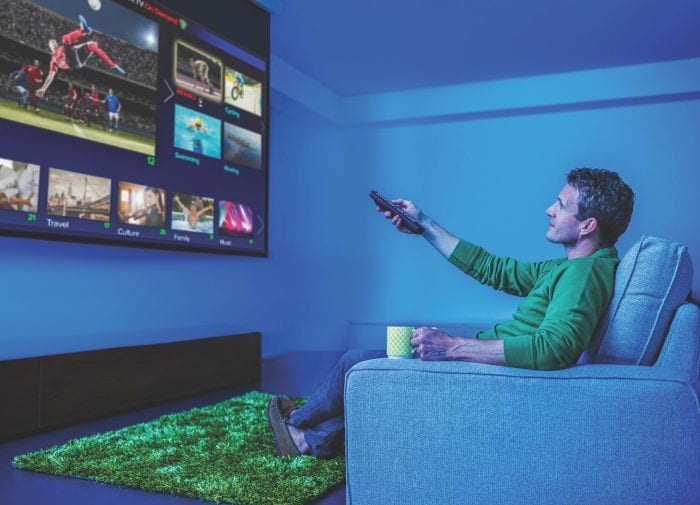
Expanded viewing habits have effects on your physical and mental health
By David Dunaief, M.D.

Comcast, one of America’s largest cable and internet providers, reported in May that Americans were watching an additional 8-plus hours of programming a week, whether on a television, computer or a portable device since the pandemic’s beginning (1). For our purposes, we’ll call this TV, because most is consumed while sitting, although the average watching modality has shifted considerably.
What impact does all this watching have on our lives? It may be hazardous to your health. I know this seems obvious, but bear with me. The extent of the effect is surprising. According to 2013 Netflix research, binge-watching, or watching more two or more episodes of a single program in a row, is perceived as providing a refuge from our busy lives.
This also has an addictive effect, prompting dopamine surges as we watch. Interestingly, it also can lead to post-binge depression when a show ends and to isolation and lower social interaction while viewing (2). Of course, while socially isolating, binge watching can help kill hours, but the negative effects are still relevant.
TV’s detrimental effect extends beyond the psychological, potentially increasing the risk of heart attacks, diabetes, depression, obesity and even decreasing or stunting longevity. My mother was right when she discouraged us from watching television, but I don’t think even she knew the extent of its impact.
Cardiovascular events including heart attacks
There was a very interesting observational study published in the New England Journal of Medicine that showed watching sporting events increases the risk of heart attacks and other cardiovascular events, such as arrhythmia (irregular heartbeat) and unstable angina (severe chest pain ultimately due to lack of oxygen). The researchers followed Germans who watched the FIFA (soccer) World Cup playoffs in 1996.
How much did watching increase the risk of cardiovascular events? This depended on what round of the playoffs and how close a game it was. The later the round and the closer the game, the greater the risk of cardiovascular events. Knockout games, which were single elimination, seemed to have the greatest impact on cardiovascular risk.
When Germany was knocked out in the semi-finals, the finals between France and Italy did not have any cardiovascular effect.
Overall, men experienced a greater than three-fold increase in risk, while women experienced an increased risk that was slightly below two-fold. According to the authors, it was not the outcome of the game that mattered most, but the intensity. The study population involved 4,279 German residents in and around the Munich area (3).
Another study found that, compared to fewer than two hours a day, those who watched four or more hours experienced an increased risk of cardiovascular disease mortality of 80 percent. I know this sounds like a lot of TV, but the average daily American viewing time is significantly over this. This study, called the Australian Diabetes, Obesity, and Lifestyle study (AusDiab) was observational looking at 8800 adults over a six-year period (4).
Impact on Life Expectancy
The adage that life tends to pass you by when you watch TV has a literal component. An observational study found that TV may reduce the life expectancy of viewers. In the study, those who watched at least six hours per day during their lifetime had a decrease in longevity of 4.8 years. However, this is not the whole story. What is even more telling is that after the age of 25, for every hour of TV, one might expect to potentially lose 21.8 minutes of life expectancy (5). According to the authors, these results rival those for obesity and sedentary lifestyles.
Diabetes and Obesity Risk
In the Nurses’ Health Study, for every two hours of television viewing on a daily basis there were increased risks of type 2 diabetes and obesity of 23 percent and 14 percent, respectively (6). The results show that sitting at work for two hours at time increased the risk of diabetes and obesity by only five percent and seven percent respectively, much less of an effect than TV-watching. The authors surmise that we can reduce the incidence of diabetes and obesity by 43 percent and 30 percent by cutting our TV time by 10 hours a week.
Modestly reducing the amount of television is a simple lifestyle modification that can have a tremendous impact on longevity, quality of life and prevention of the top chronic disease. So, step away from your television, tablet or computer and take a walk outside, do some calisthenics, or even take up a new hobby that doesn’t involve sitting on the couch. Your body and your psyche will thank you.
References:
(1) corporate.comcast.com (2) nbcnews.com/better/health/what-happens-your-brain-when-you-binge-watch-tv-series-ncna816991. (3) N Engl J Med 2008; 358:475-483. (4) Circulation. 2010 Jan 26;121(3):384-91. (5) Br J Sports Med doi:10.1136/bjsm.2011.085662. (6) JAMA. 2003 Apr 9;289(14):1785-91.
Dr. David Dunaief is a speaker, author and local lifestyle medicine physician focusing on the integration of medicine, nutrition, fitness and stress management. For further information, visit www.medicalcompassmd.com.
SBU libraries to document Stony Brook’s experience with COVID-19
The coronavirus pandemic is a time like no other in U.S. history. The virus, which hit the New York area particularly hard, had Stony Brook University and Stony Brook University Hospital on high alert for months on end.
The hospital not only saw the heroic actions of doctors and nurses already on Stony Brook Medicine’s staff, but was also assisted by visiting nurses; medical students who graduated early to help fight on the frontlines; doctors and researchers jumping on ways to find a possible cure as quickly as possible; and essential workers who played an integral role in ensuring every process and procedure ran as smoothly as possible.

On the University’s main campus, 3-D shields were printed as a PPE shortage was looming; hand sanitizer was created by several chemists in the Chemistry laboratory; and a prototype of a respirator was put together by a team from the College of Engineering and Applied Sciences which could be assembled quickly and used if necessary.
Now, Stony Brook University Libraries has announced the development of “Documenting COVID-19: Stony Brook University Experiences,” a new digital archive project established to collect, preserve, and publish the institutional history of Stony Brook University during this unprecedented moment in history.
“The archive will primarily be formed from submissions received directly from students, faculty, staff, and alumni that document life during the COVID-19 pandemic. Interviews, first-hand accounts, flyers, photographs, and more will be important sources to consult in the future to study, interpret, and derive meaning from this historic time period,” said Kristen Nyitray, University Archivist and Director of Special Collections and University Archives at Stony Brook University.
All from the Stony Brook University community are invited to contribute to the archive by submitting content or participating in an interview via a dedicated web page, “Documenting COVID-19: Stony Brook University Experiences” from which the library project team will collect information, photos, videos, personal stories and other COVID-19 related information.
For more information, visit www.library.stonybrook.edu/special-library-initiatives/documenting-covid-19/.


